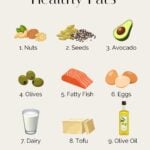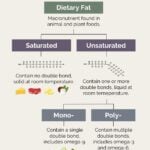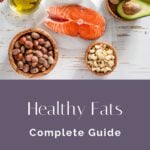Confused about healthy fats and unhealthy fats? You’re not alone. Fats come in many different shapes, sizes, and forms, and are an integral part of a healthy diet. Here is everything you need to know about healthy fats and the best sources to include in your diet.

Table of contents
Types of Dietary Fats
Dietary fats are a macronutrient found in animal and plant foods. Also known as dietary lipids, they are part of a broad class of compounds that include triglycerides, phospholipids, sterols, and waxes. Dietary fat provides 9 calories per gram and is considered an essential nutrient for survival and, therefore, must be obtained from food.
There are 2 primary types of dietary fat: saturated fat and unsaturated fat (1). Fats are classified by their bond structure, specifically the number of double bonds in their carbon chains. All fats contain a mixture of saturated and unsaturated fats, however, they are classified by the fat type they contain the most.

Saturated Fats
Saturated fats (SFAs) contain no double bonds between their carbon atoms, as the chain is “saturated” with hydrogens, which results in a very straight structure with molecules packed together very tightly (1). For this reason, saturated fats are generally solid at room temperature, which makes them great cooking fats, given that they are not prone to damage by heat. Saturated fats can be found in long-chain, medium-chain, and short-chain forms, all of which play different roles in the human body, including energy, hormone production, and cell membrane structure (2).
Sources of saturated fat include:
- Cheese
- Butter
- Fatty meats
- Cream
- Lard
- Palm oil
- Coconut oil
Saturated fats have a long history of vilification for being “unhealthy” fats. After research conducted in the 1950s, which suggested saturated fats were to blame for cardiovascular disease, saturated fats became known as “bad” fats and unsaturated fats as “good” fats. This caused major health organizations to suggest individuals replace saturated fats with polyunsaturated fats in the diet, by swapping fatty meats for lean meats, and led to the rise of low-fat and fat-free products in grocery stores, such as non-fat yogurt and low-fat muffins.
Unfortunately, this research was largely based on weak evidence from limited research that lacked context (3, 4). As research has progressed, it has become increasingly evident that it is necessary to consider the food source of the fat (i.e., whole food vs. processed food) and the overall dietary context rather than simply focusing on the type of fat consumed (i.e., overall healthy and balanced diet vs. diet high in processed foods and deep-fried foods) (5).
Moreover, more recent meta-analysis studies have not found any independent association between saturated fats and heart disease or reported a significant increase in heart disease mortality or total mortality (6).
Unsaturated Fats
Unsaturated fats contain one or more double bonds and can be broken down into two sub-categories: monounsaturated fats and polyunsaturated fats. Depending on their bond structure, unsaturated fats have one (mono-) or more (poly-) double bonds in the chain of carbons (1). Given that not all of the carbons have hydrogens connected to them, this puts a “kink” in the chain, which leaves unsaturated fats liquid at room temperature.
Monounsaturated Fats
Monounsaturated fats (MUFAs) have a single double bond in their structure. There are many types of monounsaturated fats found in our food, with oleic acid being one of the most common (1).
Similar to saturated fats, monounsaturated fats help to form the structural fats of the human body and are considered healthy. Monounsaturated fats are commonly known as “good” fats because they have been shown to have beneficial effects on cardiovascular disease risk markers by low-density lipoprotein (LDL), also known as “bad” cholesterol (7, 8).
Sources of monounsaturated fat include:
- Olive oil
- Olives
- Avocados
- Nuts (peanuts, hazelnuts, cashews, and almonds, etc.)
Polyunsaturated Fats
Unlike saturated and monounsaturated fats, polyunsaturated fats (PUFAs) have multiple double bonds in their structure (1). For this reason, polyunsaturated fats are the most susceptible to oxidative damage from light, heat, and air, especially in high-heat cooking.
There are two major types of polyunsaturated fats: omega-3 fatty acids and omega-6 fatty acids. Essential fatty acids (EFAs) are essential because the body cannot produce them, so they must be obtained from food. Omega-3 fatty acids are particularly important for their anti-inflammatory properties, benefits on cardiovascular health and the immune system, and are most efficiently derived from marine-based oils (9, 10).
Sources of polyunsaturated fat include:
- Fatty fish
- Seeds (flax seeds, chia seeds, sesame seeds, sunflower seeds, etc.)
- Nuts (walnuts, Brazil nuts, etc.)
- Vegetable oil and seed oils (canola oil, soybean oil, corn oil, etc.)
Vegetable oils, particularly seed oils, have become under great scrutiny due to their high content of omega-6 fatty acids. While omega-6 fatty acids are essential, a high intake of seed oils can increase the ratio of omega-6/omega-3 fatty acids, potentially increasing inflammation. A lower ratio of omega-6/omega-3 fatty acids is more desirable in reducing the risk of many chronic diseases (11).
While the consumption of vegetable oils and seed oils is generally considered safe, when consumed in large amounts as part of a diet high in processed foods, particularly in a calorie surplus, they may be cause for concern.
Health Benefits of Dietary Fats
Dietary fat plays several important physiological roles in the human body, including contributing to energy balance, the metabolism of fat-soluble vitamins A, D, E, and K, cell membrane function, maintenance of structure and integrity of the brain and nervous system, and hormone synthesis (12).
How much fat should you eat?
For a balanced diet, fat should make up 20-35% of total daily calorie intake (13). For instance, for a 2,000-calorie diet, 400-700 calories should come from fat, which equates to 44-78 grams of dietary fat.
While individuals can benefit from an intake above 35%, a lower fat intake has been linked with lower testosterone in men and hormone imbalance and infertility in women (14, 15). Moreover, essential fatty acids linoleic acid (LA) and alpha-linoleic acid (ALA) are widely available in Western diets, specifically inoleic acid, deficiency is possible when fat intakes are chronically below 10% of total calorie intake (16).
Currently, the Dietary Guidelines for Americans recommends limiting saturated fat intake to no more than 10% of daily calories, which is echoed by governing health bodies internationally.

What are “healthy” fats?
Put simply, healthy fats are fats found in whole foods. All natural dietary fats, including saturated, monounsaturated, and polyunsaturated fats, are essential to the human body and play vital roles.
Foods High in Healthy Fats
Here is a list of foods high in healthy fats:
- Nuts
- Seeds
- Avocados
- Olives
- Eggs
- Oily fish
- Milk
- Yogurt
- Meat
- Tofu
What are “unhealthy” fats?
Trans fats, also known as trans fatty acids (TFAs), are generally considered unhealthy fats. While trans fats naturally occur in foods from ruminant animals, such as red meat and dairy products, industrial trans fats were spawned from the demonization of saturated fats as the food industry looked to create alternatives to foods high in saturated fats, such as butter.
Trans fats were created to engineer vegetable oils, which are low in saturated and high in monounsaturated and polyunsaturated fats, to have better spreadability and a longer shelf life through hydrogenation. Hydrogenation is a chemical process that adds hydrogen to the unsaturated bonds on the fatty acid chains to turn an unsaturated fat into a saturated fat, to produce a solid fat and increase its melting point (17).
Industrial trans fats have been linked to adverse health outcomes such as systemic inflammation, endothelial dysfunction, arrhythmia, and insulin resistance (18). While naturally occurring trans fats, found in meat and dairy products from ruminant animals, have neutral health effects in moderate amounts, industrially derived trans fats, derived from vegetable oils, have a more adverse impact on blood lipids (19, 20).
The primary sources of industrial trans fats in the American diet are margarines, vegetable shortenings, and processed baked goods.
Overall, limiting unhealthy fats such as industrial trans fats and excessive saturated fats, by replacing saturated fats from rich cuts of meat with lean meats, can help to ensure you’re consuming a healthier and more balanced diet overall.
FAQs
The healthiest fats are found in whole, unprocessed foods such as nuts, seeds, avocados, olives, eggs, oily fish, milk, yogurt, meat, and tofu.
Yes, healthy fats can help to fill you up, however, they are not the most filling foods. It is best to pair fats with a source of protein and fiber to help balance blood sugar, slow digestion, and increase satiety.
Yes, healthy fats can help to support weight loss. Healthy fats from whole foods such as nuts, seeds, avocados, and olives can help to increase satisfaction and satiety. It is best to consume healthy fats as part of balanced meals in a calorie deficit for optimal weight loss results.
Yes, healthy fats are beneficial for healthy weight gain as they can help to contribute to a calorie surplus while providing micronutrients.

The Bottom Line
Healthy fats are fats from whole, unprocessed foods and include saturated fats, monounsaturated fats, and polyunsaturated fats. Healthy fats can be found in nuts, seeds, avocados, olives, eggs, oily fish, milk, yogurt, meat, and tofu. For optimal health, fats should make up 20-35% of total daily calorie intake, with saturated fat intake making up no more than 10%.






Hi! I love this article! If you want to have better view on this subject check out my small website!
Thanks a lot for this brilliant analysis- was extremely helpful for me. I can follow the idea of preferring less processed fats, but just for understanding: in how far is the production of butter, ghee, olive oil, avocado oil, or coconut oil less processed than nut oil, flax seed oil etc? Even milk or avocado need to be processed before they become butter or oil.
Thanks in advance!😊
You are correct, all oils and fats (with the exception of those still in meat, nuts, etc) are processed to some extent, including butter, ghee, and avocado oil. Not all “processed food” is inherently harmful or unhealthy (I have another article on this subject!), there are different levels of food processing. In terms of oils, as noted in the article, “vegetable” oils and many “seed” oils (such as canola) can’t be extracted by pressing or separating, these oils require extensive processing to extract their oils. The process of creating vegetable oils involves chemical extraction, degumming, refining, bleaching, and deodorizing, making them a highly processed form of oil. This does not apply to flax oil.